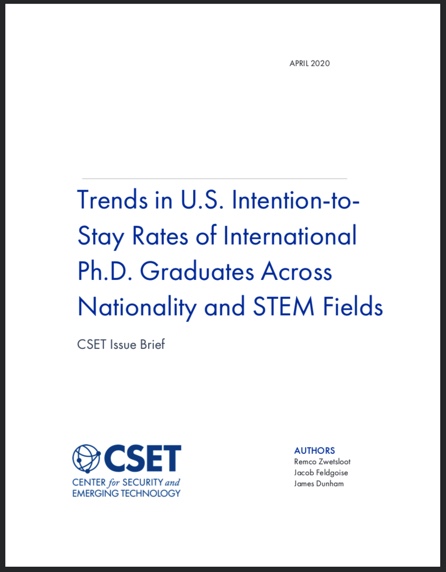Executive Summary
This Issue Brief assesses how many international Ph.D. graduates intend to stay in the United States after completing their degrees, and how these intentions differ across fields and nationalities. All analysis is based on data from the National Science Foundation’s Survey of Earned Doctorates, an annual census of all Ph.D. graduates from U.S. universities (see Box 1). Past studies show that intention-to-stay rates, the focus of this paper, correlate strongly with actual stay rates.
We find little evidence of decreasing U.S. attractiveness either among international Ph.D. students or among Chinese students specifically.Remco Zwetsloot, Jacob Feldgoise and James Dunham
The results speak to recent debates about the continued ability of the United States to attract and retain global talent. Many fear that an increase in international competition is eroding the country’s talent and innovation assets.1 Chinese students feature especially prominently in these debates due to concerns about technology transfer, and a widespread perception exists of a “reverse brain drain” of Chinese citizens leaving the United States. 2
We find little evidence of decreasing U.S. attractiveness either among international Ph.D. students in general or among Chinese students specifically. Instead, we find that:
- International students account for a large portion of U.S. STEM Ph.D. graduates, with large variation across fields. International graduates are most numerous in computer science and engineering (around 60 percent) and least numerous in the health and biological sciences (below 30 percent). In nearly all STEM fields, the proportion of graduates who are international remained constant or decreased slightly between 2010 and 2017.
- Intention-to-stay rates among international Ph.D. graduates are 70 percent or higher in all STEM fields. They are highest—between 85 and 90 percent—in computer science, biology, and engineering. Across all STEM fields, intention-to-stay rates either held steady or increased slightly between 2000 and 2017.
- Intention-to-stay rates are highest—above 85 percent—among students from Iran, India, and China. Students from richer countries, such as European Union member states and Canada, intend to stay at lower rates (around 75 percent). Intention-to-stay rates increased for students from most countries of origin between 2000 and 2017.
- The two most common countries of origin among international Ph.D. graduates are China and India. Looking closely at these graduates, we find that:
- Among graduates from China, engineering (40 percent) and the physical sciences (20 percent) are the most popular fields of study. In these and most other STEM fields, intention-to-stay rates were around 85 to 90 percent in 2017. Rates declined somewhat in the 2000–2010 period, but mostly remained constant between 2010 and 2017.
- Among graduates from India, engineering (40 percent) and the biological and health sciences (cumulatively 30 percent) are the most popular fields of study. In these and most other STEM fields intention-to-stay rates were between 85 and 95 percent in 2017, with little change between 2000 and 2017.
Download Full Issue Brief
Trends in U.S. Intention-to-Stay Rates of International Ph.D. Graduates Across Nationality and STEM Fields- For example, see James Manyika and William H. McRaven, “Innovation and National Security: Keeping Our Edge” (Council on Foreign Relations, September 18, 2019), https://www.cfr.org/report/keeping-our-edge/pdf/TFR_Innovation_Strategy.pdf; and “The Contest for Innovation: Strengthening America’s National Security Innovation Base in an Era of Strategic Competition” (Ronald Reagan Institute, December 2019), https://www.reaganfoundation.org/media/355498/the_contest_for_innovation_report.pdf.
- For example, see Michael Brown and Pavneet Singh, China’s Technology Transfer Strategy: How Chinese Investments in Emerging Technology Enable A Strategic Competitor to Access the Crown Jewels of U.S. Innovation (Washington, DC: Defense Innovation Unit Experimental, January 2018), https://admin.govexec.com/media/diux_chinatechnologytransferstudy_jan_2018_(1).pdf; and “The Contest for Innovation: Strengthening America’s National Security Innovation Base in an Era of Strategic Competition” (Ronald Reagan Institute, December 2019), https://www.reaganfoundation.org/media/355498/the_contest_for_innovation_report.pdf; and Lilian Karunungan and Yoolim Lee, “China’s Tech Boom Fueling ‘Reverse Brain Drain,’ Hillhouse Says” (Bloomberg, November 5, 2018), https://www.bloomberg.com/news/articles/2018-11-06/china-s-tech-boom-fueling-reverse-brain-drain-hillhouse-says.
